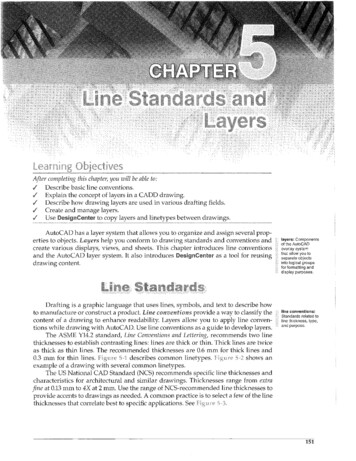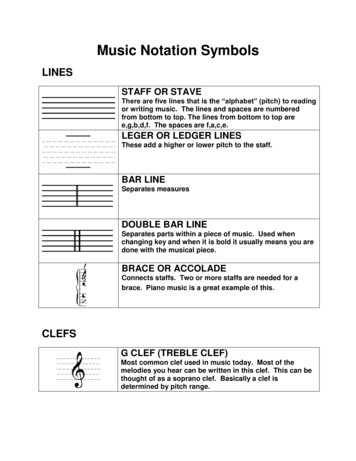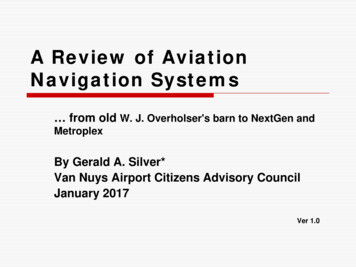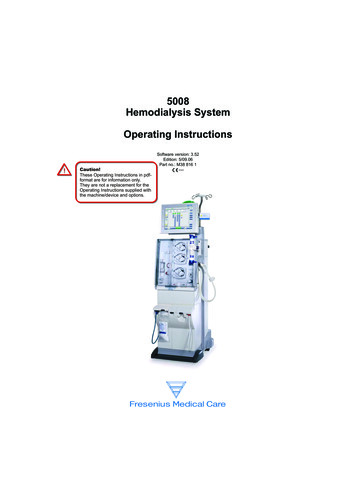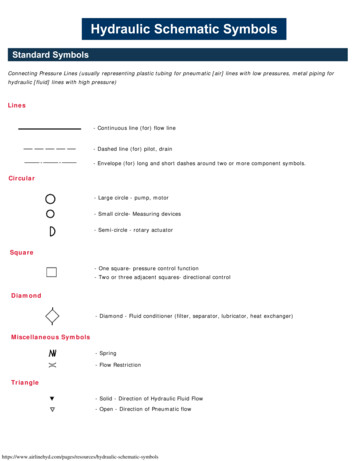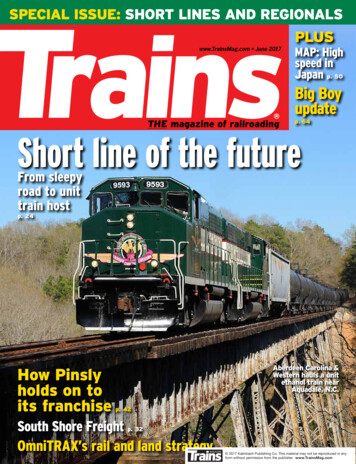
Transcription
SPECIAL ISSUE: SHORT LINES AND REGIONALSPLUSwww.TrainsMag.com June 2017MAP: Highspeed inJapan p. 50Big BoyupdateTHE magazine of railroadingp. 64Short line of the futureFrom sleepyroad to unittrain hostp. 24How Pinslyholds on toits franchiseAberdeen Carolina &Western hauls a unitethanol train nearAquadale, N.C.p. 42South Shore Freight p. 32OmniTRAX’s rail and land strategy p. 52 2017 Kalmbach Publishing Co. This material may not be reproduced in anyform without permission from the publisher. www.TrainsMag.com
COVER STORYSLEEPYSHORT LINETO BUSYUNIT TRAIN HOSTAberdeen Carolina & Western becomes short line of the futureby Jim WrinnIT IS DIFFICULT TO COMPREHEND, asyou stand on the edge of acountry road in central NorthCarolina, watching a long trainbehind six-axle power make itsway along an undulating routeof welded rail and deep ballast,that it hasn’t been long sincethe rails of the Aberdeen Carolina & Western snapped,snagged, and even sank undermuch less tonnage.This privately owned 150mile short line, shaped like awobbly Y resting on its side, ismade up of the western portionof the original Norfolk SouthernRailway’s Charlotte-RaleighNorfolk main line through theUwharrie Mountains and abranch with a surprising touchof passenger-train history.A little more than three de-24cades ago, this branch was upfor abandonment, was soldtwice, and ended up in thehands of an unlikely out-of-statebusinessman who immediatelyrealized he’d taken on a railroadwith a daunting task: Keepingtrains upright on the rails.The story today is much different. The railroad has been expanded and transformed withnewer power, heavy welded rail,and in addition to the smattering of single-car customers,you’re likely to encounter unittrains. “Not that long ago, wewere the short line of the past,”founder Bob Menzies says. “Buttoday, I like to think of us as theshort line of the future.”Such talk is not idle bragging. On some days, the railroadis so busy with unit trains that itbecomes a chess game of findingplaces for them. A modern100,000-square-foot shop is capable of handling not only thecompany’s maintenance and rebuilding needs but that of contract customers, as well. After 17years of work, the railroad brokeeven, and 20 years after its 1987inception, it turned a profit. Thisis the story of how a short linegoes from 800 to 16,000 carloads annually through perseverance, hard work, and justplain luck.There’s also an interestingand unexpected twist for a shortline running through a mostlyrural area. The railroad rostersrestored private passenger cars,and for good reason: It runsthrough the nationally knownPinehurst Resort golf course, a2017 Kalmbach Publishing Co. This material may not be reproduced in anyTrains JUNE 2017 without permission from the publisher. www.TrainsMag.comformfrequent location for entertaining customers and visitors. Thepassenger cars are easy to spotin the railroad’s signature magenta colors against the tallpines of the Carolina Sandhills.HISTORY LESSONBefore we explore therailroad of 2017, let’s reviewwhat came before and how itset up this short line’s strugglesand successes.The Aberdeen Carolina &Western is made up of tracksfrom the original NorfolkSouthern Railway. In the earlypart of the 20th century, that regional carrier bought short railroads to complete its line fromRaleigh to Charlotte, getting numerous branches in the process.According to Southeastern
Passing a Southern Railway whistle post, reflecting the line’s past, anAberdeen Carolina & Western freight rolls between Star, N.C., andGulf, N.C., with six-axle power, heavy rail, and deep ballast. Alex Keithrailroad historian Richard E.Prince’s landmark 1972 book onthe original NS, the extensionboosted the carrier to 900 routemiles. This included a branchbetween Aberdeen and Star,which originally operated underthe name Aberdeen & WestEnd, and later the Aberdeen &Asheboro. The branch had started as a logging and lumber road,and for that reason it was builtquickly and cheaply and laidmostly on top of the area’s undulating sandhills with minimalcut-and-fill work. Digging cutsor piling up fills would probablyhave been a waste of time anyway: The Sandhills area repre-sents an ancient beach that haslong been noted for its tall pines,peaches, golf, and its general inhospitality to railroads.Operation of the CharlotteRaleigh main line was remarkable for its use of five light, butmodern-for-1940, Baldwin-built2-8-4s in fast freight service.They were among the few Super-Power designs to operate inthe Deep South. Sadly, none exist today: They were all sold toMexico, where they operatedand then were scrapped.The Star-to-Aberdeenbranch was notable for anotherunlikely reason: Pullman passenger cars delivered to the doorOn May 26, 1984, in its first year of operation, Aberdeen & BriarPatch Railway GP7 No. 896 poses at Aberdeen, N.C., just feet awayfrom its interchange with CSX’s Hamlet-Raleigh main line. Jim Wrinnof the Pinehurst Resort. NSworked with trunk line Seaboard Air Line, its Class I connection at Aberdeen, to shuttlefirst-class accommodations6 miles between the interchangeand the golf resort. Regularlyscheduled Pullman service between New York City and Pinehurst began in December 1929with the appropriately namedCarolina Golfer. The train was toarrive in Aberdeen, be handedoff to the NS, and arrive in Pinewww.TrainsMag.com25
With a handful of boxcars andhopper cars in tow, westboundNorfolk Southern Railway GP18No. 5 pulls a short localbetween Aberdeen andPinehurst, N.C., in September1969. Warren CallowaySouthern Railway GP18 No. 187, from the old Norfolk Southern Railway and rebuilt with a high shorthood, hits 10 mph between Aberdeen and Star shortly before the property became a short line. Mike Smallhurst less than 30 minutes later,delivering golfers almost to thedoor. The trip between the interchange and the resort must havebeen a real show. A steep stretchof 1.8-percent grade going westbound lay between the two. Canyou imagine the sound of an engine at work and the gleam ofthe Pullman cars?But such glamorous workwas not to last long, as golfersbegan driving or flying to the26Trains JUNE 2017Carolina course. Long after thelast passenger train turned awheel and steam gave way todiesel power, freight traffic onthe 34-mile branch was workedout of Star with a single Geep orsix-axle Baldwin. There was theusual smattering of commodities, recalls retired NS conductorJohn Grabarek: pulpwood atBiscoe, furniture at West End,sand and a carpet plant just outside Aberdeen, and a few othercustomers here and there.Southern Railway purchasedthe NS Railway in 1974, primarily for access to agriculturalphosphates in eastern NorthCarolina. But deregulation in1980 and a dwindling manufacturing base in the CarolinaPiedmont and Sandhills regionschanged Southern’s thinking onits acquisition. Within the firstyear after the 1982 creation ofNorfolk Southern Railwaythrough the merger of Norfolk& Western and Southern, thenew company announced plansto abandon the Star-Aberdeensection. By then, the line was atwo-days-a-week operation, theold jointed rail was brittle, andthe Sandhills easily swallowedties. It was a slow go for thecrews: 10 mph with some5-mph sections. Long-time Carolinas rail photographer RobertGraham recalls stalking thetrain in its later days and findingit so slow that he set a personalrecord for most shots of onefreight, photographing it 51times on its plodding pace.In August 1983, the new NSsold the Star-Aberdeen line tolocal businessman Willard Formyduval, who gave the line awhimsical name, Aberdeen &Briar Patch, even though there isno place called Briar Patch,though the line does passthrough many of them. Forpower, Formyduval used former
Seaboard Coast Line GP7No. 896, until he sold the railroad just three years later toMenzies. The first owner knewsomething about the railroadthat the buyer would later cometo know all too well — the property was worn out and in desperate need of rehabilitation.Before turning it over to Menzies, Formyduval sought andwon a 1.2 million FRA grantfor track upgrades, but it wasnowhere near enough to stabilize the line. He put a classifiedad in Railway Age magazine, offering to sell the railroad, andwaited to see who would call.CLASSIFIED AD CHANGES ALLMAGENTAThe railroad got its signaturecolors when a printer returnedletterheads with what was supposed to be red. The difference was eye-catching enoughto keep, and so it stands.Soon after taking over the Charlotte-Gulf section of the former Norfolk Southern Railway main line, apair of hand-me-down Geeps prepares to run from Star to Charlotte on March 1, 1990. Jim Wrinnthat the local newspaperstopped covering them. Menzieslooked at his traffic base of twocustomers, a J.P. Stevens carpetplant in Aberdeen that receivedthree or four cars of limestoneand latex each week, and a sandplant that produced 10 heavycars for interchange with NS atStar. He wasn’t generating aprofit, let alone the money toplow into the railroad’s rehabilitation. Fortunately, money fromthe Federal Local Rail Assistance Program was available,and it began to flow from theNorth Carolina Department ofTransportation to help upgradetrack. Over the years at least 6 million in federal trackgrants has been invested in therailroad, and another 40 million of Menzies’ own money hasgone into the yrwooMo Hy dun drotGileadNondStanfielOa dkborodlaMilottearlightning bolt of good luckstrike, and learn by trial and error how a short line can utilize abig railroad tool at a profit. Itwas a steep learning curve. “Ifyou’re in the railroad business,you have to have a lot of perseverance,” Menzies says. “It’s oneof the most important qualitiesto being in this business.”That’s easy to say today, but30 years ago, it must have beentough on the days when Menzies would settle into No. 896’sengineer’s seat and notch out thethrottle, wondering if he’d makeit across the railroad without aderailment. The railroad hadfew good crossties, and the70-pound rail was long past itsprime, having been installed in1912 when the average loadedfreight car weighed 35-40 tons.Derailments were so frequentRob25 milesndScaleWestE0 2017 Kalmbach Publishing Co., TRAINS: Rick JohnsonNot all lines tte Map areaHamletGlCENTRAL CAROLINASHORT LINEChMenzies almost didn’t become the owner of the Aberdeen-to-Star line. A Michigannative, he’d studied transportation logistics at Arizona State,had taught at universities in Indiana and Kentucky, and in1972 had launched an industrial-uniform business, serving automotive plants and steel mills.But he always wanted to use hiseducation, and one day in summer 1986, he was reading Railway Age when Formyduval’sclassified ad jumped out at him.Knowing that he was alreadyset to take a trip to the NorthCarolina coast, he contactedFormyduval and arranged ameeting. After nine months ofnegotiations he purchased therailroad and renamed it Aberdeen Carolina & Western.Thus, with one locomotive,two customers, and 34 miles ofdecrepit track, Menzies startedhis new venture. Ahead lay profitability, the title of the largestshort line by route-miles inNorth Carolina, and a busy railroad with 18 customers, including two major chicken-feedplants that would devour giantunit trains of corn. But first, hehad to struggle with track, let a“It neverfailed that every week whenwe took those10 cars the 34miles at the required 10 mphover the exBob Menziescepted track,that we got on the ground atleast once and often more times.Only one train out of the 51 thatyear made it back without a derailment,” Menzies recounts inan unpublished essay he provided Trains called “So You Wantto Own a Railroad.” It is a realist’s view, laced with a touch ofhumor, of the struggles of starting a short line. In the essay, herecounts the derailment of asand hopper, and how he hiredthe neighboring Aberdeen &Rockfish short line to rerail it.www.TrainsMag.com27
MAGENTA PASSENGERCARS AND F UNITSShort lines, private varnish, and cab units are notsupposed to co-exist, but this trio is coming together inside theAberdeen Carolina & Western’s spacious shop building in Candor, N.C.Two of the three elements are already are in place: the railroad and theprivate cars. The pride of the office-car fleet is the 1917 Roamer,acquired in 2012 in anticipation of special events during the U.S. OpenChampionship golf tournament in Pinehurst. The car, which had beenstored inside, still required extensive work: More than 30 layers ofinterior paint came off, and it took the efforts of a Smithsonian-trainedconservator to revive the car’s beautiful oak interior, complete with goldleaf. Private car Pinehurst is a Pullman with a 24-seat dining room, alounge, and a kitchen. A third car, Mission Santa Ynez, was completedin 2015. Other cars in the fleet include two diners, two domes, and twoflatcars with railings, which the railroad describes to outsiders as “patiocars.” The railroad’s Geeps or SDs currently pull the passenger cars,but that is about to change. After all, a passenger train isn’t trulycomplete without appropriate power, so the railroad acquired and hasbeen slowly rebuilding an A-B-A set of former Milwaukee Road F7s thatcame via Ohio Central. The only problem with getting the units rebuiltand on the road is the pace of business. “We’re just so busy. It’s hard tofind time to work on them,” laments Vice President-Mechanical DaleParks. A 2016 visit showed the F units rebuilt inside and getting newexterior panels. In the coming years, whether it needs to impressvisitors or business people, the Aberdeen Carolina & Western will haveitself one spiffy executive trainset in the Carolina Sandhills. — Jim WrinnShop crews have been slowly working on an A-B-A set of F unitsfor use on special trains. At right is a former Southern Pacificoffice car under restoration. Two photos, Tr a i ns : Jim WrinnThree restored heavyweight private cars in the fleet, solariumMission Santa Ynez, parlor Pinehurst, and observation carRoamer, shine in the railroad’s trademark magenta color.28Trains JUNE 2017Menzies and his crew of fourwere soon joined by eight members of the Aberdeen & Rockfish track gang. “As we were onsandy fill, I watched day afterday as they tried to jack up thiscar using crossties as their jacking pad. The only problem was,the more they jacked, the morethe ties disappeared into the fill,and the railcar didn’t budge. Alltold, over 100 crossties werejacked into that fill with no results. It took over a week in 95102 degree weather before wecalled it quits. As there was noway to unload the car becauseof its inaccessibility, I learnedthe hard way to just call in acouple of high-rail cranes andget the pain over with. That carcost between 30,000- 40,000to pick up with no insurance tocover those costs.”SUCCESS IS JUST CHICKEN FEEDThe turning point in the railroad’s future came in 1987 whenPerdue Farms located a giantchicken-feed mill in Candor,N.C., about 22 miles from Aberdeen. While Menzies and hiscrew struggled to move coveredhoppers of corn across the railroad without derailments, he focused the railroad’s efforts onthe worst parts of the track —the curves where super-elevations from the steam era werehighly exaggerated. Menziesbrought in others to consult,and they admitted that the railroad might be too difficult andcostly to rebuild.Menzies kept on. His firststep was to get fresh ballast,but he couldn’t afford newrock. He bought used ballastinstead, after CSX pulled upthe second track on its HamletRaleigh main line. Used rockcost 2 per ton vs. 8 for freshballast. Colleagues advised himagainst the move — a lot of itmight be sand, they said — butMenzies pointed out that hisrailroad was already laid onsand. The recovered rockwould still be an improvement.Then, he went looking forrail, at least 100 pounds per yardor more. As more heavy railwent in at the cost of millions,derailments became fewer andless frequent. By the time a second chicken-feed mill, Moun-Ed Thumtainaire Farms,located its ownplant in Candor in 2000,the railroadwas starting tolook and feelmore like itwas going tosurvive.But with every opportunitycomes a challenge. This time itwas one that would transformthe railroad into what it is today.It is a universally acceptedmethod of operations on mainline railroads for decades but ararity in the shortline world:Unit trains.Menzies recalls that Mountainaire began bringing 50-carunit trains from the NS interchange at Gulf, N.C. That wasthe good news. But instead ofearning a profit from the trains,they were costing the railroadbig money. After unit trainspounded a wood bridge so hardit required a 250,000 fix, Menzies began studying why unittrains were costing him more torun than they earned.He soon learned that eachunit train, just to go 40 miles,cost the railroad 8,000 to 10,000 more in fuel, labor, andtrack maintenance than itearned. Traction motors on hisolder locomotives were alsopunished on these heavy trains.Unit trains are cost-effectivefor Class I railroads, he surmised, but they can be costly toa short line if they’re not managed carefully. In his own railroad’s case, each unit train required as many as eight elderlyGP7s or GP9s because of theroller-coaster profile.“This required us on the dayof a unit train to round up allour locomotives, then run lightthe 40 miles, wait for NS toshow up, haul the unit train toour customer, then after he hadfinished unloading, take theempties back to the interchange,then run light again back to ourterminal to disperse our locomotives back to their normalchores of bringing in 10 or 20cars at a time on a daily basis,”Menzies wrote in his essay.“Unit trains at 6,600 tons arehard on your locomotives andhard on your track structure. In
The engineer aboard AberdeenCarolina & Western SD40-3No. 6909 is all business as heleads five additional units andhis train past a church and intoCandor, N.C., on June 4, 2014.Unit trains are the basicoperating component for therailroad today. Steve Smedleyfact, we found our 90-poundrail, which was made in 1924,was starting to crumble underthe weight of these trains.”Menzies brought in a Sperrycar to test his rails for flaws every six months, and with eachtrip, more than 150 defectswould be revealed. The solutionwas buying 114-, 132-, and141-pound welded rail — andmaking a change in operations.Another 5 miles of weldedrail was installed in 2016. Today,all of the Sandhills section of therailroad between Aberdeen andStar is made up of welded rail,and the section from Star toCharlotte that sees less tonnagehas been upgraded from85-pound jointed rail to100-pound jointed rail.But track upgrades were notall that changed to make unittrains work. At the start, unittrains required the short line’spower at interchange, but now,With six-axle power as well kept as the neighboring golf resort, Aberdeen Carolina & Western moves a unitrock train through Pinehurst, N.C., on Oct. 3, 2011. Note the thick ballast under the train. Kenneth LehmanCSX power operates through,onto the short line. DedicatedAberdeen Carolina & Westerncrews handle unit trains, andnormal operations aren’t disturbed. Keeping the Class I railroad’s six-axle units on the pointsaves significant time.Unit trains themselves havechanged since the railroad began handling them. Mountainaire has expanded its plantfive times to become the largestfeed mill in the region, and thathas meant a constantly hungryfacility that can devour one unittrain of corn after another. Thetrains themselves grew from 50cars to 65, and recently to 95,weighing in at 10,000 tons andmaking good infrastructure vital. The pace is a challenge, too.Sometimes as many as five unittrains can be on line at one time.That’s when track space becomes a problem, and the railroad finds itself in a chess game,moving one train out of the wayof another.“You have to plan yourmoves in advance,” says Operations Vice President Ed Thum.The railroad can get backed upquickly with one misstep. “If theClass I connection doesn’t pickup your cars from the interchange and you’re blocked,you’ve got a problem,” he says.Leaving the CSX interchangeat Aberdeen, loaded trains facethat slow climb on 3 miles of1.8-percent grade. A pair ofES44ACs, front and back, getsdown and grinds its way up thehill, topping out at 10 mph ifthe crew is lucky.In addition to corn forchicken feed, the railroad haulsunit trains of outbound aggregates and inbound ethanol. Thelatter go to a Cargill plant onwww.TrainsMag.com29
In a classic shortline terminal scene, an Aberdeen Carolina & Western train switches Star, N.C., wherethe Aberdeen branch and the former Norfolk Southern main line intersect. Kenneth Lehmanthe Charlotte section for distribution to gasoline makers. Unittrains make up 60 percent ofthe railroad’s business.Having survived the badtrack era and the learningcurve for unit trains, Menziessays that the recipe for a successful short line is to have oneor two anchor customers, likethe chicken-feed mills, thatsupport the railroad and allowit to grow and expand.“When I first bought therailroad, we had three or foursmall customers,” Menzies says.“When Perdue came along Iknew that would be an anchor.It would not make us completely profitable, but it gave us abase to build from, and withoutthat we wouldn’t have made it.”Today the railroad also haulsplastics, outbound dimensionallumber, wood chips, brick, inbound butane, and propane.Menzies is also adamantabout finding new customers inthe six-county region that therailroad serves, from the fastgrowing suburban Charlottearea, to the rural central part ofNorth Carolina, and the golfresort area of the CarolinaSandhills.“You have to always belooking for new business,” hesays. “Now that the railroad isin good shape, we can focus onthat.” It’s important, he says, be30Trains JUNE 2017cause no industry is guaranteed. Not one of the railroad’soriginal handful of customers isstill a shipper or even in business. And there’s room to growin other areas: The companyhas become a contract maintenance vendor for industrial locomotives in the region, saysVice President-MechanicalDale Parks.Today, thebusiest part ofthe railroad isthe Star-toAberdeenbranch withthe Star-Charlotte line operated every othDale Parkser day. TheStar to Gulf section is run asneeded with the NS interchangeat Gulf dormant. Cars going toNS are handed off at the yard onthe north side of uptown Charlotte. The railroad also interchanges with the Winston-Salem Southbound Railway, a16,000Number of carloads AberdeenCarolina & Western handleseach year. Annual carloadswhen Bob Menzies bought therailroad in 1987: 800.regional that’s jointly owned byCSX and NS, at Norwood.TRANSITIONS INPOWER AND PEOPLEThe railroad shifted over theyears from older secondhandGeeps to newer-but-used fouraxle power. Then it made a bigswitch to six-axle power that became available during the GreatRecession,Parks says. Today, the linestables 20 locomotives, including sevenwide-nosedGP40-2s ofCanadian NaCarl Hollowelltional heritage,12 SD40-3s of various lineages,and one slug. The six-axle unitsare especially useful on frequent, short, steep grades, andtheir Spartan cabs give themgreat crew visibility duringswitching. Their pulling poweris unmatched. “With the six-axle units, two of them can do thework of four GPs,” Parks says.You’ll find all of the locomotivesneatly attired in the company’sgreen, cream, and magentapaint scheme.The units are cared for in thenew shops the railroad acquiredin 2015 in Candor, just downthe tracks from its two biggestcustomers.The shop complex also houses freight car repair and a placeto work on the company’s 12car passenger fleet. It also houses the headquarters offices forMenzies, Parks, Thum, VicePresident ofOperationsand GeneralManager CarlHollowell, andrecentlynamed President JenniferHarrell — aJenniferfamily memHarrellber who wasin charge of marketing and became president last fall in amove to ensure continuity.Menzies continues to serve thecompany as chairman, and hesays he plans for the railroad tocontinue as an independent operator for years to come. “I get acall about once every weekwanting to know if we’d like tosell,” he says of shortline holdingcompanies that have proliferated and come to dominate thebusiness in the last 20 years.“We’ve no interest in selling therailroad.”What Menzies does have aninterest in, besides keeping up
Symbol of success: At the endof a long day, an AberdeenCarolina & Western unit graintrain ties down at the PerdueFarms chicken-feed mill inCandor, N.C., one of the line’stwo major customers.the infrastructure and wooingnew customers, is his passengercar fleet. The railroad uses itspassenger cars for business recruitment and special excursions. The cars were highly visible during the June 2014 U.S.Open Championship golf tournament at Pinehurst as a stationary hospitality suite.In a story in the MooreCounty newspaper, The Pilot,Menzies described how hiscompany did not need to rent ahospitality suite for the event —he brought his own. “This hassome of the best views,” Menziessaid in the story, describing howhe stood in a flatcar equippedwith railings and a canopy caroverlooking the driving andpractice ranges at the PinehurstResort clubhouse. “It’s our corporate tent.”The passenger train becamea place to entertain the shortline’s guests as well as state andlocal economic development of-A set of Aberdeen Carolina & Western units moves covered hoppers for switching at Aberdeen, N.C.Grain for chicken feed is one of the railroad’s principal commodities. Two photos, AC&W: Chris Aumanficials seeking to bring businessto the area and to the railroad.Freight trains were scheduled torun at night in order to avoidthe tournament and its crowds.The U.S. Open is set to return toPinehurst in 2024, and you cancount on the Aberdeen Carolina& Western to be ready to serveas a willing host once more.In the meantime, trains ofgrain, rock, ethanol, and general freight move across heavyrail and deep ballast wherethere once was none. There’s always more track work to do.Menzies likes to say that hisperseverance kept him in thebusiness during the AberdeenCarolina & Western’s early, dif-ficult, derailment-prone days.Years of hard work, learningfrom mistakes, and investingheavily in the franchise havepaid off. It has led him and histeam to an era of stability andprofitability on a most unlikelyrailroad plunked down in thePiedmont and Sandhills ofNorth Carolina. 2www.TrainsMag.com31
THE magazine of railroading www.TrainsMag.com June 2017 PLUS MAP: High speed in Japan p. 50 Big Boy update p. 64 Aberdeen Carolina & Western hauls a unit ethanol train near Aquadale, N.C. SPECIAL ISSUE: SHORT LINES AND REGIONALS . you stand on the edge of a country road in central North Carolina, watching a long train behind six-axle .




